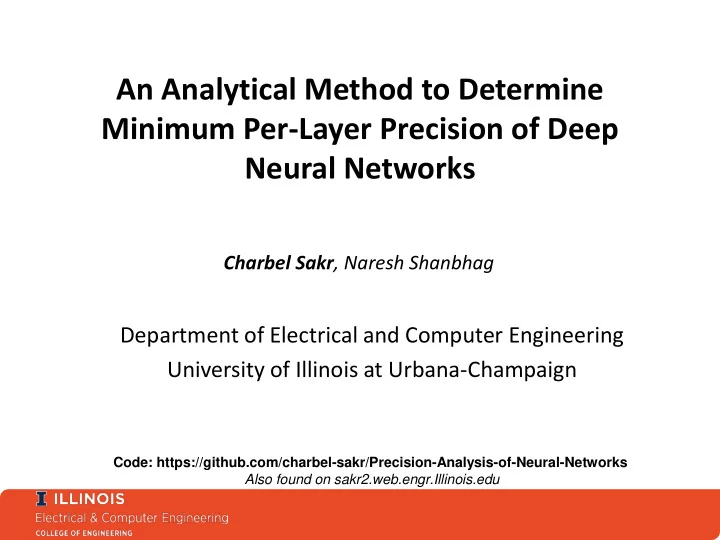

An Analytical Method to Determine Minimum Per-Layer Precision of Deep Neural Networks Charbel Sakr , Naresh Shanbhag Department of Electrical and Computer Engineering University of Illinois at Urbana-Champaign Code: https://github.com/charbel-sakr/Precision-Analysis-of-Neural-Networks Also found on sakr2.web.engr.Illinois.edu
Machine Learning ASICs Eyeriss PuDianNao TPU [Sze’16, ISSCC] [Chen’15, ASPLOS] [Google’17, ISCA] AlexNet accelerator ML accelerator Tensorflow accelerator 16b fixed-point 16b fixed-point 8b fixed-point How are they choosing these precisions? Why is it working? Can it be determined analytically?
Current Approaches • Stochastic Rounding during training [Gupta, ICML’15 – Hubara , NIPS’16] → Difficulty of training in a discrete space No accuracy • Trial-and- error approach [Sung, SiPS’14] → Exhaustive search is expensive vs. precision understanding • SQNR based precision allocation [Lin, ICML’16] → Lack of precision/accuracy understanding Fixed-point Quantization
International Conference on Machine Learning (ICML) - 2017
Precision in Neural Networks Classification Output Quantization Mismatch Probability Floating-point Network Fixed-point Network 𝑞 𝑛 : “Mismatch Probability” [Sakr et al., ICML’17]
Second Order Bound on 𝒒 𝒏 • Input/Weight precision trade-off: → Optimal precision allocation by balancing the sum • Data dependence (compute once and reuse) → Derivatives obtained in last step of backprop → Only one forward-backward pass needed weight quantization noise gain activation quantization noise gain [Sakr et al., ICML’17]
Proof Sketch • For one input, when do we have a mismatch? → If FL network predicts label “ 𝑘 ” → But FX network predicts label “ 𝑗 ” where 𝑗 ≠ 𝑘 → This happens with some probability computed as follows: (Output re-ordering due to quantization) (Symmetry of quantization noise) → But we already know → Whose variance is → Applying Chebyshev + LTP yields the result [Sakr et al., ICML’17]
Tighter Bound on 𝒒 𝒏 • Mismatch probability decreases double exponentially with precision → Theoretically stronger than Theorem 1 → Unfortunately, less practical 𝑁 : Number of Classes 𝑇 : Signal to quantization noise ratio 𝑄1 & 𝑄2 : Correction factors [Sakr et al., ICML’17]
Per-layer Precision Assignment (i (activations) • Per-layer precision allows for more aggressive complexity reductions • Layer 1 Search space is huge: 2L (weights) dimensional grid • Example: 5 layer network, precision considered up to 16 bits → 16 10 ≈ one million millions design points • We need an analytical way to reduce the search space → maybe using the analysis of Sakr et al. Layer L key idea: equalization of reflected quantization noise variances
Fine-grained Precision Analysis [Sakr et al., ICML’17] per-layer quantization noise gains [Sakr et al., ICASSP’18]
Per-layer Precision Assignment Method equalization of quantization noise variances Step 1 : compute least quantization noise gain Step 2 : select precision to equalize all quantization noise variances Search space is reduced to only a one dimensional axis of reference precision min
Comparison with related works • Simplified but meaningful model of complexity → Computational cost → Total number of FAs used assuming folded MACs with bit growth allowed → Number of MACs is equal to the number of dot products computed → Number of FAs per MAC: → Representational cost → Total number of bits needed to represent weights and activations → High level measure of area and communications cost (data movement) • Other works considered → Stochastic quantization (SQ) [Gupta’15, ICML] → 784 – 1000 – 1000 – 10 (MNIST) → 64C5 – MP2 – 64C5 – MP2 – 64FC – 10 (CIFAR10) → BinaryNet (BN) [Hubara’16, NIPS] → 784 – 2048 – 2048 – 2048 – 10 (MNIST) & VGG (CIFAR10)
Precision Profiles – CIFAR-10 VGG-11 ConvNet on CIFAR-10: 32C3-32C3-MP2-64C3-64C3-MP2-128C3-128C3-256FC-256FC-10 Precision chosen such that 𝑞 𝑛 ≤ 1% • Weight precision requirements greater [Sakr et al., ICML’ 17] • Precision decreases with depth – more sensitivity to perturbations in early layers [Raghu et al., ICML’ 17]
Precision – Accuracy Trade-offs • Precision reduction is the greatest when using the proposed fine- grained precision assignment
Precision – Accuracy – Complexity Trade-offs • Best complexity reduction when the proposed precision assignment • Complexity even much smaller than a BinaryNet for same accuracy due to much higher network complexity
Conclusion & Future Work • Presented an analytical method to determine per-layer precision of neural networks • Method based on equalization of reflected quantization noise variances • Per-layer precision assignment reveals interesting properties of neural networks • Method leads to significant overall complexity reduction, e.g., reduction of minimum precision to 2 bits and lesser cost of implementation than BinaryNets • Future work: • Trade-offs between precision vs. depth vs. width • Trade-offs between precision and pruning
Thank you! Acknowledgment: This work was supported in part by Systems on Nanoscale Information fabriCs (SONIC), one of the six SRC STARnet Centers, sponsored by MARCO and DARPA.
Recommend
More recommend